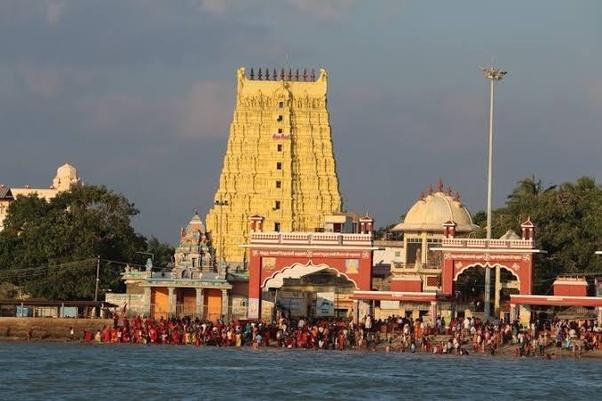Rameswar Temple: A Divine Abode in the Heart of India
The Rameswar Temple, located in the picturesque town of Rameswaram in Tamil Nadu, is one of the most revered and significant temples in India. Dedicated to Lord Shiva, this temple is part of the Char Dham pilgrimage and is steeped in mythological and historical importance. Here’s an in-depth guide to exploring the spiritual charm and architectural grandeur of the Rameswar Temple.
Historical and Mythological Significance
The Legend of Lord Rama
The Rameswar Temple is intricately linked to the epic Ramayana and the legendary deeds of Lord Rama.
- Mythological Roots: According to legend, Lord Rama worshipped Lord Shiva here to absolve himself of the sin of killing Ravana, a Brahmin. He instructed Hanuman to bring a lingam from the Himalayas, but when Hanuman delayed, Sita made a lingam out of sand, which is worshipped as the main deity in the temple.
- Sacred Site: The temple is one of the twelve Jyotirlingas, which are considered the holiest Shiva temples. Pilgrims from all over the country visit Rameswaram to seek blessings and perform rituals, making it a crucial site for Hindu devotees.
Architectural Marvel
Dravidian Architecture
Rameswar Temple is a splendid example of Dravidian architecture, characterized by towering gopurams (gateway towers), intricate carvings, and expansive corridors.
- Majestic Gopurams: The temple boasts impressive gopurams at its entrances, with the eastern Rajagopuram standing at around 53 meters tall. These structures are adorned with intricate sculptures depicting various deities and mythological scenes.
- Long Corridors: The temple is renowned for having the longest corridor among all Hindu temples in India, measuring about 1,200 meters in length. The corridors, lined with beautifully carved pillars, create a mesmerizing sight and offer a serene pathway for devotees.
- Intricate Sculptures: The walls and pillars of the temple are adorned with detailed carvings and sculptures, showcasing the artistic brilliance of the artisans. These intricate designs narrate various mythological stories and add to the temple’s spiritual ambiance.
Spiritual Practices and Rituals
Sacred Baths and Pujas
The Rameswar Temple is not just a place of worship but also a site for various spiritual practices and rituals.
- Theerthams (Sacred Water Tanks): The temple complex houses 22 theerthams, or sacred water tanks, where pilgrims perform ritual baths before entering the main shrine. Each theertham is believed to have distinct purifying properties, and taking a dip in these waters is considered a vital part of the pilgrimage.
- Abhishekam and Puja: Devotees can participate in the abhishekam (ritual bathing of the deity) and various pujas conducted throughout the day. These rituals are performed with great devotion and are believed to bring blessings and spiritual merit to the participants.
Visitor Experience
Temple Timings and Entry
Visitors to the Rameswar Temple can experience its spiritual aura and architectural splendor throughout the year.
- Timings: The temple is open from early morning till late evening, with specific timings for different rituals and darshans (viewing of the deity). It is advisable to check the schedule in advance to plan your visit accordingly.
- Entry and Dress Code: While there is no entry fee, visitors are expected to adhere to a modest dress code, covering their shoulders and legs. Traditional attire is preferred, and footwear must be removed before entering the temple complex.
Nearby Attractions
Rameswaram offers several other attractions that enhance the spiritual and cultural experience for visitors.
- Dhanushkodi: A short drive from the temple, Dhanushkodi is a ghost town with a fascinating history and scenic views of the confluence of the Bay of Bengal and the Indian Ocean.
- Pamban Bridge: The iconic Pamban Bridge connects Rameswaram to the mainland and offers breathtaking views of the sea. It is a marvel of engineering and a popular spot for photography.
- Gandhamadhana Parvatham: This hillock, located about 3 kilometers from the temple, offers panoramic views of the island and is believed to be the spot where Lord Rama’s footprints are imprinted on a chakra.
Practical Tips for Visitors
Best Time to Visit: The best time to visit Rameswar Temple is from October to April when the weather is pleasant and conducive for temple visits and sightseeing. Avoid the peak summer months due to the intense heat.
Accommodation: Rameswaram offers a range of accommodation options, from budget lodges to mid-range hotels and guesthouses. It is advisable to book in advance, especially during the peak pilgrimage season.
Transportation: The town is well-connected by road and rail. The nearest airport is Madurai, about 170 kilometers away. Local transportation options include auto-rickshaws, cycle rickshaws, and taxis.
Etiquette and Respect: Maintain decorum and respect the sanctity of the temple. Follow the instructions of temple authorities and be mindful of the customs and traditions.
Reflection and Farewell
A visit to the Rameswar Temple is a spiritual journey that offers a profound connection to the divine and a glimpse into the rich cultural heritage of India. From its mythological roots and architectural grandeur to the serene rituals and vibrant surroundings, the temple encapsulates the essence of devotion and divinity.
Plan your pilgrimage to Rameswar Temple and immerse yourself in the spiritual ambiance of this sacred abode. Experience the divine presence of Lord Shiva and the timeless legacy of one of India’s most revered temples.






Leave feedback about this